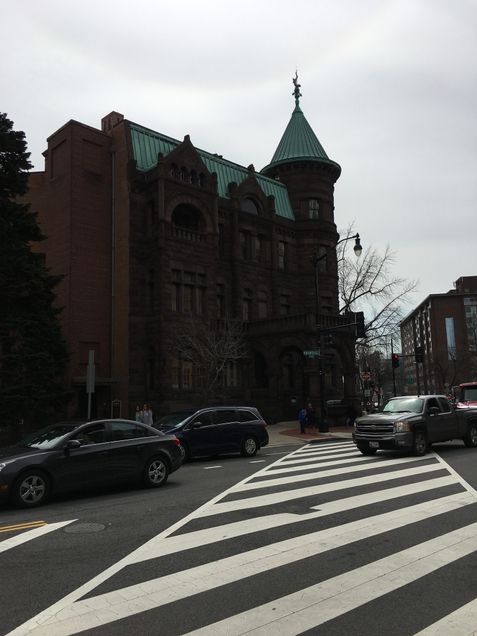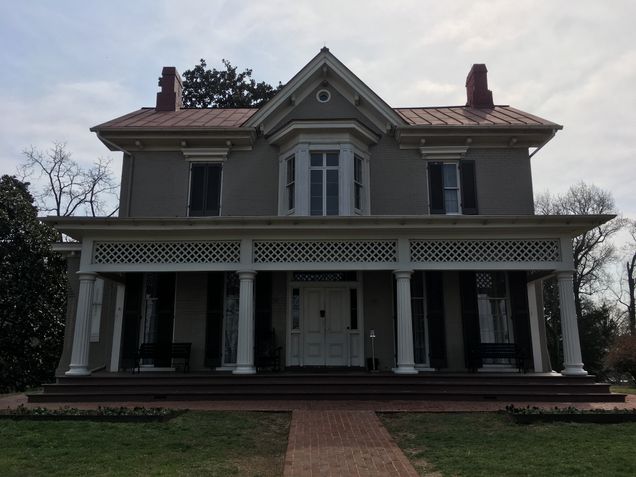DC Off the Beaten Path: House Edition
by Aaron Whitaker (Spring 2017)
DC is known by most for its cluster of museums and monuments located along the National Mall. However, a large part of DC’s culture and history is defined by its quieter residential neighborhoods. The following attractions are all lesser-known historical residences, which showcase different styles of living in different time periods and different aspects of DC Culture.

Heurich House near Dupont Circle. Photo: Aaron Whitaker
- Heurich House: 1307 New Hampshire Avenue NW
DC has long been known as a hub of diverse ethnic cultures, due to its large number of immigrants, as well as a city with a social drinking culture. Christian Heurich contributed to both of these aspects of DC, as he was a German immigrant who was the first person to open a large scale brewery in the city. His castle-like house was built in 1894 and incorporated his love for beer, having a small pub in the basement. Heurich was also a man obsessed with technology, therefore his home is equipped with many modern amenities that were ahead of their time.
- Woodrow Wilson House: 2340 S Street NW
Another aspect of DC Culture is an obsession with presidents and the monuments that commemorate them. The Woodrow Wilson house is where he and his wife resided until their deaths, and, prior to her passing in 1961, Mrs. Wilson bequeathed the home and its furnishings to the National Trust for Historic Preservation to serve as a monument to President Wilson. The house itself is built in a Georgian Revival Style and includes several ornate features, including a marble entryway which opens into a grand staircase, a book-lined study, and a large downstairs kitchen featuring a “state of the art” dumb waiter and butler’s pantry.

One of the many unique interior bathroom designs in the Mansion on O Street. Photo: Aaron Whitaker
- The Mansion on O Street: 2020 O St. NW
DC is often noted as having some of the most unique architecture in the country, and the Mansion on O Street is the epitome of a uniquely designed interior and exterior. The Mansion on O Street is actually a series of five interconnected town houses that includes 100 rooms and more than 70 secret doors. The mansion was designed in 1892 by Edward Clark, architect for the US Capitol and previously housed the FBI’s G-men Today, the mansion acts as a strange combination of museum, hotel, and event center, and contains many one of a kind pieces of furniture. Although the entrance fee is a bit heft at $15, I found the price to be well worth it and the experience to be quite thrilling.

The Japanese Garden at the Hillwood Estate. Photo: Aaron Whitaker
- Hillwood Estate, Museum and Gardens: 4155 Linnean Ave NW
While DC is an urban center, it takes pride in its many parks and green spaces. The Hillwood Estate is just one example of a luscious open space in DC. The estate was purchased by Marjorie Merriweather Post in 1955 who decided she wanted her home to be a museum following her death. She, therefore, spent years decorating the house with 18th century French décor while updating the house with the most modern conveniences. In addition to the mansion itself, the estate has a luscious garden with lots of open space and artwork and two additional buildings reflecting Ms. Posts interests in architecture.

Frederick Douglass house in Anacostia. Photo: Aaron Whitaker
- Frederick Douglass House: 1411 W St SE
A large part of DC’s history and culture has been defined its African American population, many who came seeking refuge from slavery and segregation they faced in the South. One man who broke the barriers of color was Frederick Douglass, who held several high-ranking federal appointments, including U.S. Marshal for D.C., Recorder of Deeds for D.C., and Minister Resident and Consul General to Haiti. His former home, nestled in a residential neighborhood of Anacostia, was built in 1859 for John Welsh, a Philadelphia architect, and consisted of 6 to 14 rooms. When Douglass began receiving his federal appointments in 1877, the government therefore hooked him up with a place to stay, and he purchased the home and nearly 10 acres of property from the Freedmen’s Savings Trust and company. In 1878, he and his wife Anna moved in. Douglass lived in the home until his death in 1895. Douglass’s second wife, Helen, resided in the home until her death in 1903, but ensured that Congress charter the Frederick Douglass Memorial and Historical Association (FDMHA). In 1962, the estate became a unit of the National Park Service and plans for restoration were put into place. The house officially reopened to the public in 1972, and the current visitor center opened a decade later.
Aaron is a senior studying political science, interning at the Department of Justice, and actively looking for a full-time job post-graduation in Washington.

